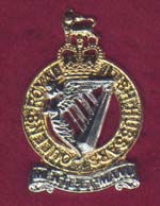
Queen's Royal Irish Hussars
Encyclopedia


Cavalry regiments of the British Army
There are currently nine regular cavalry regiments of the British Army, with two tank regiments provided by the Royal Tank Regiment, traditionally classed alongside the cavalry, for a total of eleven regiments. Of these, five serve as armoured regiments, and five as formation reconnaissance...
of the British Army
British Army
The British Army is the land warfare branch of Her Majesty's Armed Forces in the United Kingdom. It came into being with the unification of the Kingdom of England and Scotland into the Kingdom of Great Britain in 1707. The new British Army incorporated Regiments that had already existed in England...
formed from the amalgamation of the 4th Queen's Own Hussars
4th Queen's Own Hussars
The 4th Queen's Own Hussars was a cavalry regiment in the British Army, first raised in 1685. It saw service for three centuries, before being amalgamated into The Queen's Royal Irish Hussars in 1958....
and the 8th King's Royal Irish Hussars
8th King's Royal Irish Hussars
The 8th King's Royal Irish Hussars was a cavalry regiment in the British Army, first raised in 1693. It saw service for three centuries, before being amalgamated into The Queen's Royal Irish Hussars in 1958....
in Hohne
Hohne
Hohne is a municipality in the state of Lower Saxony in Germany, east of the county town of Celle. It includes the three former parishes of Hohne, Helmerkamp and Spechtshorn...
, West Germany
West Germany
West Germany is the common English, but not official, name for the Federal Republic of Germany or FRG in the period between its creation in May 1949 to German reunification on 3 October 1990....
in 1958.
The Regimental Journal and the Polo Team were nicknamed 'The Crossbelts', which was taken from a nickname earned by the 8th Hussars at the Battle of Alemenaro in 1710. Many customs and practices of the two predecessor regiments were retained by the QRIH, such as the green and gold tent hat worn without a badge which was used by officers
Officer (armed forces)
An officer is a member of an armed force or uniformed service who holds a position of authority. Commissioned officers derive authority directly from a sovereign power and, as such, hold a commission charging them with the duties and responsibilities of a specific office or position...
.
The regiment was amalgamated with The Queen's Own Hussars on 1 September 1993, to form The Queen's Royal Hussars (The Queen's Own and Royal Irish).
History
The regiment moved to AdenAden
Aden is a seaport city in Yemen, located by the eastern approach to the Red Sea , some 170 kilometres east of Bab-el-Mandeb. Its population is approximately 800,000. Aden's ancient, natural harbour lies in the crater of an extinct volcano which now forms a peninsula, joined to the mainland by a...
in 1961, reroling as an armoured reconnaissance regiment and after serving there against insurgents for almost a year, sailed on the SS Oxfordshire to the newly-independent nation of Malaysia. It was based in Ipoh
Ipoh
Ipoh is the capital city of Perak state, Malaysia. It is approximately 200 km north of Kuala Lumpur on the North-South Expressway....
, Malaysia from October 1962, and saw limited action against Indonesia
Indonesia
Indonesia , officially the Republic of Indonesia , is a country in Southeast Asia and Oceania. Indonesia is an archipelago comprising approximately 13,000 islands. It has 33 provinces with over 238 million people, and is the world's fourth most populous country. Indonesia is a republic, with an...
n insurgents, seeing service in Brunei
Brunei
Brunei , officially the State of Brunei Darussalam or the Nation of Brunei, the Abode of Peace , is a sovereign state located on the north coast of the island of Borneo, in Southeast Asia...
and Sarawak
Sarawak
Sarawak is one of two Malaysian states on the island of Borneo. Known as Bumi Kenyalang , Sarawak is situated on the north-west of the island. It is the largest state in Malaysia followed by Sabah, the second largest state located to the North- East.The administrative capital is Kuching, which...
on jungle operations during the Indonesian confrontation, and in Singapore
Singapore
Singapore , officially the Republic of Singapore, is a Southeast Asian city-state off the southern tip of the Malay Peninsula, north of the equator. An island country made up of 63 islands, it is separated from Malaysia by the Straits of Johor to its north and from Indonesia's Riau Islands by the...
as part of the Internal Security Forces. Returning to West Germany
West Germany
West Germany is the common English, but not official, name for the Federal Republic of Germany or FRG in the period between its creation in May 1949 to German reunification on 3 October 1990....
in 1964 the regiment was based in Wolfenbüttel
Wolfenbüttel
Wolfenbüttel is a town in Lower Saxony, Germany, located on the Oker river about 13 kilometres south of Brunswick. It is the seat of the District of Wolfenbüttel and of the bishop of the Protestant Lutheran State Church of Brunswick...
, near the East German border as part of NATO forward defences. Further deployments were:
- 1968-1970: United Kingdom, Recce Role at Perham Down until 1969, then RAC Centre regiment, Bovington.
- 1970-1979: PaderbornPaderbornPaderborn is a city in North Rhine-Westphalia, Germany, capital of the Paderborn district. The name of the city derives from the river Pader, which originates in more than 200 springs near Paderborn Cathedral, where St. Liborius is buried.-History:...
at Barker Barracks, as part of the 7th Armoured Brigade7th Armoured BrigadeThe 7th Armoured Brigade or 7th Armored Brigade may refer to any of a number of military units:*7th Armoured Brigade *7th Armoured Brigade *7th Armoured Brigade...
.
- 1974-1977: CyprusCyprusCyprus , officially the Republic of Cyprus , is a Eurasian island country, member of the European Union, in the Eastern Mediterranean, east of Greece, south of Turkey, west of Syria and north of Egypt. It is the third largest island in the Mediterranean Sea.The earliest known human activity on the...
, whilst based in Paderborn, as part of the UN peacekeeping forceUnited Nations Peacekeeping Force in CyprusThe United Nations Peacekeeping Force in Cyprus was established in 1964 to prevent a recurrence of fighting between the Greek Cypriots and Turkish Cypriots and to contribute to the maintenance and restoration of law and order and a return to normal conditions...
following the invasionTurkish invasion of CyprusThe Turkish invasion of Cyprus, launched on 20 July 1974, was a Turkish military invasion in response to a Greek military junta backed coup in Cyprus...
of the northern part of the island by TurkeyTurkeyTurkey , known officially as the Republic of Turkey , is a Eurasian country located in Western Asia and in East Thrace in Southeastern Europe...
.
- 1979-1982: United Kingdom, including short tours to RhodesiaRhodesiaRhodesia , officially the Republic of Rhodesia from 1970, was an unrecognised state located in southern Africa that existed between 1965 and 1979 following its Unilateral Declaration of Independence from the United Kingdom on 11 November 1965...
and Cyprus. Main body of the regiment was based at Bhurtpore Barracks in TidworthTidworthTidworth is a town in south-east Wiltshire, England with a growing civilian population. Situated at the eastern edge of Salisbury Plain, it is approximately 10 miles west of Andover, 12 miles south of Marlborough, 24 miles south of Swindon, 15 miles north by north-east of Salisbury and 6 miles east...
as the UKLF (reserve) tank regiment, with C Squadron detached to the School of Infantry at WarminsterWarminsterWarminster is a town in western Wiltshire, England, by-passed by the A36, and near Frome and Westbury. It has a population of about 17,000. The River Were runs through the town and can be seen running through the middle of the town park. The Minster Church of St Denys sits on the River Were...
where it was used in the role of RAC Demonstration Squadron.
- 1982-1988: MünsterMünsterMünster is an independent city in North Rhine-Westphalia, Germany. It is located in the northern part of the state and is considered to be the cultural centre of the Westphalia region. It is also capital of the local government region Münsterland...
, York Barracks, as part of the 4th Armoured Brigade, 3rd Armoured Division, British Army of the RhineBritish Army of the RhineThere have been two formations named British Army of the Rhine . Both were originally occupation forces in Germany, one after the First World War, and the other after the Second World War.-1919–1929:...
. During this posting the regiment celebrated its Tercentenary and was presented with a new GuidonGuidonGuidon may refer to:*Guidon , a type of heraldic flag*Guidon , a swallow tailed flag for the colours of a light cavalry regiment...
by HRH Prince Phillip.
- 1983: Northern IrelandNorthern IrelandNorthern Ireland is one of the four countries of the United Kingdom. Situated in the north-east of the island of Ireland, it shares a border with the Republic of Ireland to the south and west...
, whilst based at Münster, as Prison Guard Force at Maze Prison.
- United Kingdom 1988-1990 - Half the regiment to Cambrai Barracks, CatterickCatterick GarrisonCatterick Garrison is a major Army base located in Northern England. It is the largest British Army garrison in the world with a population of around 12,000, plus a large temporary population of soldiers, and is larger than its older neighbour...
, RAC Training Regiment. The other half as RAC Centre Regiment, Bovington.
- Fallingbostel 1990-1995
- IraqIraqIraq ; officially the Republic of Iraq is a country in Western Asia spanning most of the northwestern end of the Zagros mountain range, the eastern part of the Syrian Desert and the northern part of the Arabian Desert....
(1991), Gulf WarGulf WarThe Persian Gulf War , commonly referred to as simply the Gulf War, was a war waged by a U.N.-authorized coalition force from 34 nations led by the United States, against Iraq in response to Iraq's invasion and annexation of Kuwait.The war is also known under other names, such as the First Gulf...
(whilst based at Fallingbostel) following the Iraqi invasionInvasion of KuwaitThe Invasion of Kuwait, also known as the Iraq-Kuwait War, was a major conflict between the Republic of Iraq and the State of Kuwait, which resulted in the seven-month long Iraqi occupation of Kuwait, which subsequently led to direct military intervention by United States-led forces in the Gulf...
of KuwaitKuwaitThe State of Kuwait is a sovereign Arab state situated in the north-east of the Arabian Peninsula in Western Asia. It is bordered by Saudi Arabia to the south at Khafji, and Iraq to the north at Basra. It lies on the north-western shore of the Persian Gulf. The name Kuwait is derived from the...
, spearheading the 7th Armoured Brigade100 hour advance, reprising the role of Desert Rats as performed by both predecessor regiments in World War 2 in the North African Campaign.
Victoria Cross
Victoria Cross
The Victoria Cross is the highest military decoration awarded for valour "in the face of the enemy" to members of the armed forces of various Commonwealth countries, and previous British Empire territories....
es include:
- James ChampionJames ChampionJames Champion VC MSM was an English recipient of the Victoria Cross, the highest and most prestigious award for gallantry in the face of the enemy that can be awarded to British and Commonwealth forces.-Details:...
- Full list of medals - Joseph WardJoseph Ward (VC)Joseph Ward VC was born in Kinsale, County Cork, and was an Irish recipient of the Victoria Cross, the highest and most prestigious award for gallantry in the face of the enemy that can be awarded to British and Commonwealth forces....
- John PearsonJohn Pearson (VC)John Pearson VC was an English recipient of the Victoria Cross, the highest and most prestigious award for gallantry in the face of the enemy that can be awarded to members of the British and Commonwealth forces.-Details:...
- Samuel ParkesSamuel Parkes (VC)Samuel Parkes VC was an English recipient of the Victoria Cross, the highest and most prestigious award for gallantry in the face of the enemy that can be awarded to British and Commonwealth forces...
- Clement Walker HeneageClement Walker HeneageMajor Clement Walker Heneage VC was an English recipient of the Victoria Cross, the highest and most prestigious award for gallantry in the face of the enemy that can be awarded to British and Commonwealth forces.-Details:...
- George HollisGeorge HollisGeorge Hollis VC was an English recipient of the Victoria Cross, the highest and most prestigious award for gallantry in the face of the enemy that can be awarded to British and Commonwealth forces.-Details:...
Battle honours
There is a combined total of 538 years service from the formation of the parent regiments until the amalgamation which was to create the QRIH. During this time 102 Battle Honours were awarded to the regiments. 40 of these appeared on the QRIH Guidon.Equipment
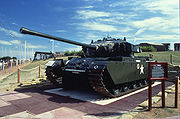
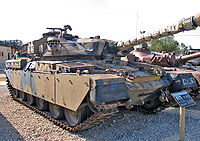
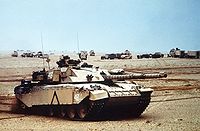
Main battle tank
A main battle tank , also known as a battle tank or universal tank, is a tank that fills the heavy direct fire role of many modern armies. They were originally conceived to replace the light, medium, heavy and super-heavy tanks. Development was spurred onwards in the Cold War with the development...
regiment of the Royal Armoured Corps
Royal Armoured Corps
The Royal Armoured Corps is currently a collection of ten regular regiments, mostly converted from old horse cavalry regiments, and four Yeomanry regiments of the Territorial Army...
.
Post amalgamation, the two types used by the regiment were primarily Centurion
Centurion tank
The Centurion, introduced in 1945, was the primary British main battle tank of the post-World War II period. It was a successful tank design, with upgrades, for many decades...
and Chieftain
Chieftain tank
The FV 4201 Chieftain was the main battle tank of the United Kingdom during the 1960s and 1970s. It was one of the most advanced tanks of its era, and at the time of its introduction in 1966 had the most powerful main gun and heaviest armour of any tank in the world...
. As with all MBT regiments however the QRIH did have other armoured vehicles in service in parallel with their main role. These included:
- ConquerorConqueror tankThe FV 214 Conqueror, also known as "Tank, Heavy No. 1, 120 mm Gun, Conqueror" was a British heavy tank of the post-war era. It was developed as a response to the Soviet Joseph Stalin IS-3 heavy tanks and carried a larger 120 mm gun compared to the 20-pounder gun carried by its peer the...
- ScimitarFV107 ScimitarFV107 Scimitar is an armoured reconnaissance vehicle used by the British Army. It is very similar to the FV101 Scorpion but mounts a high velocity 30 mm L21 RARDEN cannon instead of a 76 mm gun. It was issued to Royal Armoured Corps, Armoured Regiments in the Reconnaissance role...
- ScorpionFV101 ScorpionThe FV101 Scorpion is a British armoured reconnaissance vehicle. It was the lead vehicle and the fire support type in the Combat Vehicle Reconnaissance , CVR, family of seven armoured vehicles...
- SpartanFV103 SpartanFV103 Spartan is a tracked armoured personnel carrier of the British Army. It was developed as the APC variant of the Combat Vehicle Reconnaissance family. The vehicle can carry up to 7 personnel, including 3 crew members. Armed with a single machine gun, it is almost indistinguishable from the...
- SaladinAlvis SaladinThe Saladin is a six-wheeled armoured car built by Alvis, and fitted with a 76mm gun.Used extensively by the British Army, it replaced the AEC Armoured Car that had been in service since World War II.-History:...
- SaracenAlvis SaracenThe FV603 Saracen is a six-wheeled armoured personnel carrier built by Alvis and used by the British army. It became a recognisable vehicle as a result of its part in the policing of Northern Ireland.-History:...
- SultanFV105 SultanFV105 Sultan is a British Army command and control vehicle based on the CVR platform. It has a higher roof than the APC variants, providing a more comfortable "office space" inside. This contains a large vertical map board and desk along one side, with a bench seat for three people facing it...
- SamaritanFV104 SamaritanThe FV104 Samaritan is the British Army armoured ambulance variant of the CVR family. It has a capacity for up to 6 casualties.The Samaritan is one of the variants of the Combat Vehicle Reconnaissance family of armoured fighting vehicles developed by Alvis plc for the British military....
- FerretFerret armoured carThe Ferret armoured car, also commonly called the Ferret Scout car, is a British armoured fighting vehicle designed and built for reconnaissance purposes. The Ferret was produced between 1952 and 1971 by the UK company, Daimler...
- 432FV432The FV432 is the armoured personnel carrier variant of the British Army's FV430 series of armoured fighting vehicles. Since its introduction in the 1960s it has been the most common variant, being used for transporting infantry on the battlefield...
During the first Gulf War when the regiment deployed it did so with, what was then, the latest British main battle tank, Challenger
Challenger tank
There have been three tanks named Challenger in British military service.* Cruiser Mk VIII Challenger in service during World War II* Challenger 1 in service from the late 1980s to early 21st century* Challenger 2 in service from 1998 onwards...
or as it is now referred to since the introduction of the second of the Challenger series Challenger 1
Challenger 1 tank
The British FV4030/4 Challenger 1, was the main battle tank of the British Army from 1983 to the mid 1990s, when it was superseded by the Challenger 2. It is also currently used by the Jordanian Armed Forces as their main battle tank after heavy modifications...
.
In addition, for command, control and administration, some "soft skinned" vehicles were also in use:
- Bedford TrucksBedford VehiclesBedford Vehicles, usually shortened to just Bedford, was a subsidiary of Vauxhall Motors, itself the British subsidiary of General Motors , established in 1930; and constructing commercial vehicles. Bedford Vehicles was a leading international truck manufacturer, with substantial export sales of...
known as "3 Tonners" and "4 Tonners" - StalwartAlvis Stalwart (FV620)The FV 620 Stalwart, informally known by servicemen as the 'Stolly', is a highly mobile amphibious military truck built by Alvis that served with the British Army.-History:...
- Land Rovers
Some vehicles were modified for specific use with an armoured regiment. Some 4 ton trucks for example had a modular set of fuel tanks with dispensing nozzles to increase the speed at which tanks could be refueled during combat (much faster and cleaner than emptying Jerrycan
Jerrycan
A jerrycan is a robust fuel container originally made from pressed steel. It was designed in Germany in the 1930s for military use to hold 20 litres of fuel. The development of the Jerrycan was a huge improvement on earlier designs, which required tools and funnels to use.-Uses:Today similar...
s of fuel into the 220 gallon fuel tanks). Others even more notably such as the Armoured Recovery Vehicle (ARV) used by the mechanics and fitters from the REME
Royal Electrical and Mechanical Engineers
The Corps of Royal Electrical and Mechanical Engineers is a corps of the British Army that has responsibility for the maintenance, servicing and inspection of almost every electrical and mechanical piece of equipment within the British Army from Challenger II main battle tanks and WAH64 Apache...
who were responsible for the recovery and repair of broken down or damaged vehicles.
Structure
As with all armoured regiments the structure was based around the Squadron concept. The number of troops in a squadron changed and so did the number of squadrons but the basic premise remained and still remains the same.Headquarter Squadron (HQ Sqn) - command, control and administration. Recce and Guided Weapons troops were also a component part of HQ Sqn.
A Squadron (D of E Sqn) - Sabre*
B Squadron (B Sqn) - Sabre
C Squadron (C Sqn) - Sabre
D Squadron (D Sqn) - Sabre
* The designation "Sabre" indicates a fighting squadron, a throwback to the days of horses.
Regimental music
The Regimental Quick March was "The Queen's Royal Irish Hussars" (an arrangement of St Patrick's Day, Berkley's Dragoons and The Galloping Queen's Hussar, preceded by the regimental trumpet call).The regimental slow march was "Litany of Lorretto".
The regimental Hymn was Abide With Me
Abide With Me
The hymn tune most often used with this hymn is "Eventide" composed by William Henry Monk in 1861.Alternate tunes include:* "Abide with Me," Henry Lyte, 1847* "Morecambe", Frederick C...
The regimental song was "The Galloping Queen's Hussar" (A version of the "Galloping 8th Hussar" from the 8th King's Royal Irish Hussars):
- The Regimental Song
I'm a soldier in the Queen's Army
I'm galloping Queen's Hussar
I've sailed the ocean wide and blue,
I'm a chap who knows a thing or two,
Been in many a tight corner,
Shown the enemy who we are,
I can ride a horse,
Go on a spree, or sing a comic song,
And that denotes a Queen's Hussar!
Regimental days
The regiment celebrated two special days in each year. St Patrick's Day and BalaklavaBalaklava
Balaklava is a former city on the Crimean peninsula and part of the city of Sevastopol which carries a special administrative status in Ukraine. It was a city in its own right until 1957 when it was formally incorporated into the municipal borders of Sevastopol by the Soviet government...
Day (celebrating the Charge of the Light Brigade
Charge of the Light Brigade
The Charge of the Light Brigade was a charge of British cavalry led by Lord Cardigan against Russian forces during the Battle of Balaclava on 25 October 1854 in the Crimean War. The charge was the result of a miscommunication in such a way that the brigade attempted a much more difficult objective...
). On most occasions these were holidays for all soldiers with sporting activities during the day and celebrations in the evening. These holidays began with the quaint tradition of senior nco's Non-commissioned officer
Non-commissioned officer
A non-commissioned officer , called a sub-officer in some countries, is a military officer who has not been given a commission...
serving Gunfire http://www.drinksmixer.com/drink4048.html (a mixture of tea and rum) to junior soldiers as a morning wake-up drink. During active operations the festivities were suspended but the occasion always marked in some way. On St Patrick's Day each soldier would wear a sprig of shamrock
Shamrock
The shamrock is a three-leafed old white clover. It is known as a symbol of Ireland. The name shamrock is derived from Irish , which is the diminutive version of the Irish word for clover ....
, normally presented by the honorary colonel, Prince Phillip who had assumed the role upon the death of Sir Winston Churchill
Winston Churchill
Sir Winston Leonard Spencer-Churchill, was a predominantly Conservative British politician and statesman known for his leadership of the United Kingdom during the Second World War. He is widely regarded as one of the greatest wartime leaders of the century and served as Prime Minister twice...
.
Regimental mottoes
The regimental motto was the LatinLatin
Latin is an Italic language originally spoken in Latium and Ancient Rome. It, along with most European languages, is a descendant of the ancient Proto-Indo-European language. Although it is considered a dead language, a number of scholars and members of the Christian clergy speak it fluently, and...
Mente et Manu of the 4th Hussars, meaning With Mind and Hand which was inscribed on the cap badge and regimental crest. The motto of the 8th Hussars was also retained Pristinae Virtutis Memores (Mindful of former valour).
Colonels in Chief
The first Colonel in Chief was Sir Winston ChurchillWinston Churchill
Sir Winston Leonard Spencer-Churchill, was a predominantly Conservative British politician and statesman known for his leadership of the United Kingdom during the Second World War. He is widely regarded as one of the greatest wartime leaders of the century and served as Prime Minister twice...
who was known as the "Greatest Hussar of all time". After his death in 1965 Cornets from the Regiment stood vigil over his catafaulque in Westminster and carried his coffin to the funeral train and to the graveside . The Colonelcy then passed to Prince Phillip who retained the position until amalgamation.
Regimental Colonels
The last Colonel of the Regiment was Major General John Strawson, the eminent military author and historian. Former commanding officer of the 4th Hussars and the Queen's Royal Irish Hussars who saw service in various theatres during World War Two.External links
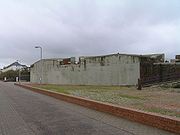
- The Queen's Royal HussarsThe Queen's Royal HussarsThe Queen's Royal Hussars is the senior United Kingdom light cavalry regiment. It was formed on 1 September 1993 from the amalgamation of The Queen's Own Hussars and The Queen's Royal Irish Hussars...
- Eastbourne RedoubtEastbourne RedoubtEastbourne Redoubt is a fort on what is now Royal Parade, Eastbourne, East Sussex, England.-History:The Redoubt was built between 1804 and 1810 to support the associated Martello towers in defending against the threat of an invasion by Napoleon. It has defended the Eastbourne coast for nearly 200...
(Eastbourne Redoubt Fortress Military Museum, Home of the Regimental Museum) - 24 National Virtual Museum Website
- 4th(Queen's Own)Hussars, 8th(King's Royal Irish) Hussars Victoria Crosses

